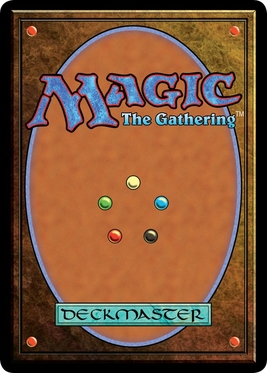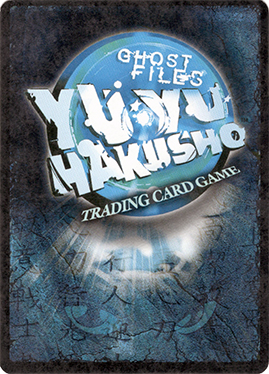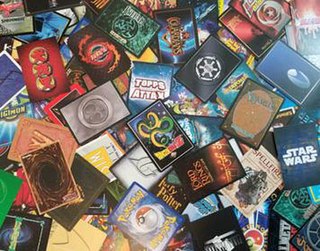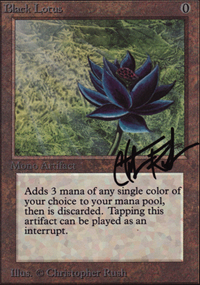
Magic: The Gathering is a tabletop and digital collectible card game created by Richard Garfield. Released in 1993 by Wizards of the Coast, Magic was the first trading card game and had approximately fifty million players as of February 2023. Over twenty billion Magic cards were produced in the period from 2008 to 2016, during which time it grew in popularity. As of the 2022 fiscal year, Magic generates over $1 billion in revenue annually.

The Yu-Gi-Oh! Trading Card Game is a collectible card game developed and published by Konami. It is based on the fictional game of Duel Monsters created by manga artist Kazuki Takahashi, which appears in portions of the manga franchise Yu-Gi-Oh! and is the central plot device throughout its various anime adaptations and spinoff series.
Vampire: The Eternal Struggle is a multiplayer collectible card game published by Wizards of the Coast (1994-1996), then White Wolf Publishing (1996-2010) and after several years of hiatus, by Black Chantry Productions (2018-present). It is set in the World of Darkness and is based on the Vampire: The Masquerade roleplaying game.

Magic: The Gathering Online is a video game adaptation of Magic: The Gathering, utilizing the concept of a virtual economy to preserve the collectible aspect of the card game. It is played through an Internet service operated by Wizards of the Coast, which went live on June 24, 2002. The game does not run on mobile as Magic: the Gathering Arena does, since it is only available for Microsoft Windows. Users can play the game or trade cards with other users.

The Yu Yu Hakusho Trading Card Game was first published in 2003 by Score Entertainment, and is based on the anime and manga series YuYu Hakusho. It is a two-player tournament-styled collectible card game; each player uses a deck of forty-four or more cards that is headed by a team of four character cards. The game was discontinued in 2005.
The Odyssey is a Magic: The Gathering expert-level block. It consists of a trio of expansion sets: Odyssey, Torment and Judgment.
The collectible card game Magic: The Gathering published seven expansion sets from 1993 to 1995, and one compilation set. These sets contained new cards that "expanded" on the base sets of Magic with their own mechanical theme and setting; these new cards could be played on their own, or mixed in with decks created from cards in the base sets. With Magic's runaway success, many of the printings of these early sets were too small to satisfy the rapidly growing fanbase. Cards from them became rare, hard to find, and expensive. It was not until Fallen Empires and Homelands that Wizards of the Coast was able to print enough cards to meet demand; additionally, Wizards of the Coast published Chronicles, a reprint set that helped fix many of the scarcity issues with the earliest sets.
In Magic: The Gathering, Power Nine is a set of nine cards that were printed in the game's early core sets, consisting of Black Lotus, Ancestral Recall, Time Walk, Mox Pearl, Mox Sapphire, Mox Jet, Mox Ruby, Mox Emerald, and Timetwister. These nine cards were printed in the first sets of Magic: The Gathering, starting in 1993. They are considered among the most powerful cards in the game. Owing to their power, they were banned from being played in most competitive settings.
The collectible card game Magic: The Gathering published nine base sets from 1993–2007, also referred to as core sets. The base sets were considered descendants of the original Limited Edition, and shaped the default setting and feel of Magic. These sets consisted entirely of reprinted cards. These cards were generally simpler than cards in expansion sets, omitting multicolored cards, and used only the original abilities and keywords of Magic such as Flying and Trample. This simplicity led to many cards from these sets being considered "staples" of deck design. All cards were given a white border to mark them as reprints, with a few exceptions. From Fourth Edition in 1995 onward, a new base set would come out once per two years in the spring or early summer; for tournament play, that set would be legal for two years in the Standard format until the next core set replaced it.
Gameplay of the collectible card game Magic: The Gathering is fueled by each player's deck of cards, which constitute the resources that player can call upon to battle their opponents in any given game. With more than 20,000 unique cards in the game, a considerable number of different decks can be constructed. Each card is designed to have certain strengths and therefore a significant part of the game is determined by which cards a player chooses to include in their deck. Broadly speaking, decks can be loosely classified based on their play style and mode of victory. The game's designers often explicitly create cards which are intended to fuel one or more of these given archetypes, in order to create competitive balance and diversity.

The Harry Potter Trading Card Game is an out-of-print collectible card game based in the world of J. K. Rowling's Harry Potter novels. Created by Wizards of the Coast in August 2001, the game was designed to compete with the Yu-Gi-Oh!, Pokémon and Magic: The Gathering card games. Its release was timed to coincide with the theatrical premiere of the first film in the series. The game was praised for the way it immersed children in the Harry Potter universe. At one point the game was the second best selling toy in the United States; however, it is now out of print.
Portal is the name given to the three Magic: The Gathering starter level sets. The original Portal was released on May 1, 1997, followed by Portal Second Age on June 24, 1998 and Portal Three Kingdoms on July 6, 1999. The Portal set was inspired by Chinese mythology; Three Kingdoms in particular by the 14th century Chinese historical novel Romance of the Three Kingdoms by Luo Guanzhong.

Wyvern is an out-of-print collectible card game featuring dragons and wyverns battling for treasure. The game was produced by U.S. Games Systems, with the first, "Premiere Limited", card set launched in January 1995. In 1997, the "Kingdom Unlimited" edition was released, featuring 277 cards, and marking the end of production.
Magic: The Gathering formats are various ways in which the Magic: The Gathering collectible card game can be played. Each format provides rules for deck construction and gameplay, with many confining the pool of permitted cards to those released in a specified group of Magic card sets. The Wizards Play Network, the governing body that oversees official Magic competitive play, categorizes its tournament formats into Constructed and Limited. Additionally, there are many casual formats with the Commander format being one of the most popular formats of the game.

Magic: The Gathering is a video game published by MicroProse in March 1997 based on the collectible card game Magic: The Gathering. It is often referred to as Shandalar after the plane of Shandalar, where the game takes place. The player must travel the land and fight random enemies to gain cards, and defeat five wizards representing the five colors. The player must prevent one color from gaining too much power, and defeat the planeswalker Arzakon, who has a deck of all five colors. Adventure and role-playing elements are present, including inventory, gold, towns, dungeons, random battles, and character progression in the form of new abilities and a higher life point total. An oversized version of Aswan Jaguar was included in the game box.
The rules of Magic: The Gathering were originally developed by the game's creator, Richard Garfield, and accompanied the first version of the game in 1993. The rules of Magic have been changed frequently over the years by the manufacturer, Wizards of the Coast, mostly in minor ways. However, major rules overhauls have also been done a few times.

A collectible card game (CCG), also called a trading card game (TCG) among other names, is a type of card game that mixes strategic deck building elements with features of trading cards. It was introduced with Magic: The Gathering in 1993.

Android: Netrunner is an Expandable card game (ECG) produced by Null Signal Games, previously by Fantasy Flight Games. It is a two-player game set in the dystopian future of the Android universe. Each game is played as a battle between a megacorporation and a hacker ("runner") in a duel to take control of data. It is based on Richard Garfield's Netrunner collectible card game, produced by Wizards of the Coast in 1996.
A sideboard, side deck, or side is a set of cards in a collectible card game that are separate from a player's primary deck. It is used to customize a match strategy against an opponent by enabling a player to change the composition of the playing deck.

Black Lotus is a card in the collectible card game Magic: The Gathering. Wizards of the Coast published the card in the earliest editions of the game, and it has become one of the game's most valuable collectible cards.










